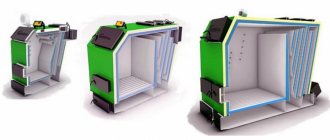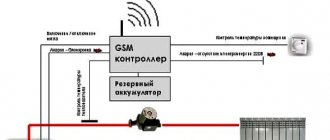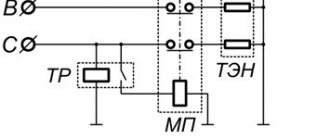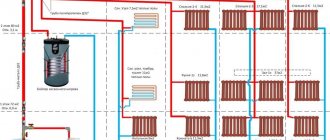Creating heating in your own home implies the use of automation as a mandatory element. You won’t constantly sit in the boiler room and manually monitor the operation of the boiler and other operating parameters of the system itself. And it is better to ensure comfortable conditions in the house not by opening the windows, although no one has canceled ventilation in the rooms, but by setting the desired temperature. These are the tasks that the automation of heating systems performs.
Components of a heating control system
What needs to be automated?
Considering how a house is heated, it should be noted that the operation of the automatic heating system should cover at least the following components:
- heating boiler operation;
- providing comfortable living conditions;
- saving fuel and operating equipment in a gentle manner.
As a rule, when choosing a heating boiler, we already partially determine what kind of heating automation will be used. The fact is that manufacturers of high-quality similar equipment include a heating control unit in the design.
Its task is to create a safe operating mode for the boiler, for which additional sensors are used. As a rule, such a heating system controller monitors safety and provides:
- protection against coolant overheating;
- protection against increases and decreases in pressure in the system;
- control of boiler filling with water;
- control of gas pressure in the line (for gas heating);
- exhaust gas pressure control.
Some of these functions can be installed at the customer’s request (optional), but automatic heating control, at least the operation of the boiler, will be complete with this approach.
The operation of a modern boiler is controlled using a special panel
How to connect and configure
Installation of any automation for a solid fuel boiler is approximately the same. You need to follow a number of simple steps:
- Place the automation unit in a place inaccessible to overheating. It is not at all necessary to install the automation unit very close to the boiler or on its body. It is much more important to define it in such a way as to avoid overheating, even taking into account possible emergency situations. The maximum distance is determined by the permissible length of cables for connecting the fan, circulation pump and sensors, which can range from 2 to 10 meters.
- Connect a fan to supply air on the combustion door instead of the ash damper or in a separately prepared hole. For older boiler models, you will have to manually cut and prepare a hole for the fan. In modern boilers, installation is carried out in a prepared place.
- Install the coolant temperature sensor. It is best to measure the water temperature directly in the boiler heat exchanger or inside the main heat storage tank. For this purpose, boilers often provide a special seat or hole up to 60 mm deep. If it is not possible to fix the sensor on the heat exchanger, then it is transferred to the boiler outlet pipe through which the hottest coolant flows. More often, the manufacturer advises using a clamp with a thermal pad for better contact.
- Connect all equipment to the controller using power and signal wires. For the fan, circulation pump and sensors, corresponding pairs of terminals are allocated, mounted on the body of the automation unit. Their markings and position should be checked with the instructions from the manufacturer.
- The initial settings are set: target coolant temperature. The maximum and minimum volume of air supplied by the fan to the combustion chamber. Limits of permissible change in water temperature in the boiler.
The programming algorithm and settings of the automatic control unit for solid-fruit boilers are established by the manufacturer and are described in detail in the instructions.
About automatic control of the heating system
When considering the automation of heating systems, it should be borne in mind that heating can be controlled by temperature:
GSM module for heating boilers: purpose and operation of the remote controller
- coolant;
- air in the house;
- outside air, weather dependent.
Control systems based on coolant temperature control operate regardless of current conditions. The consequence of this will be high inertia of the entire process, low efficiency and wastefulness. The best results are shown by an automatic heating system that works to maintain the set temperature in the house.
Elements of a weather-compensated heating control system
Weather-dependent regulation is considered the most progressive and effective, since it allows you to quickly respond to changing environmental conditions. However, conventional means that monitor and control the heating system can ensure its fairly efficient operation.
What is included
The contents depend on the manufacturer and model of the product. The following parts are included as standard.
Controller (GSM module) is a device with a different number of inputs, expandable if you need to connect additional functions. Models in the low price segment contain a couple of standard functions and operating modes. More expensive devices have a pre-built control regulator for a week.
Portable temperature sensors, from two to ten - it depends on the type of module. Designed for different rooms, including outdoor ones. The optimal number is five, provided that one of them will be on the street.
Standard type of heat sensor (outdoor and room) for regulating temperature indicators in the entire house or in certain rooms
A GSM antenna is required to strengthen the signal. She is responsible for establishing uninterrupted communication with the owner of the equipment and with the towers of the cellular operator.
Through a relay (in most models up to 3 pcs.) feedback is provided to the owner. In the user manual for all modules there is a list of codes that characterize all normal and abnormal situations and codes for feedback.
Standard equipment of the gsm module using the example of the 4T model from . All components are connected and prepared for installation (+)
Additional sensors (such as motion and fire) are also required. More often, users independently purchase them depending on their needs.
The battery may be additionally present in some models. Manufacturers most often use lithium-ion. This is an important component because battery life depends on it. If the voltage is turned off, the power will automatically transfer to the battery.
The battery capacity should be enough for full operation of the GSM module for at least five hours, preferably up to two days. If you know that power outages occur frequently in your area, then it makes sense to purchase a battery with a larger capacity.
Touch memory electronic key reader in the Xysal GSM module model. Used to protect against unauthorized intervention in boiler control
In addition, the kit includes an electronic key reader, a touch screen, connectors for connecting to the boiler, and coils of connecting wires. If necessary, you can purchase additional components or “assemble” the set to suit your needs.
How it works
It should be noted here that automation for heating a private home can be built using a variety of devices, operating both autonomously and under the control of centralized systems.
Control using a heating boiler
With this approach, all heating control comes down to setting the temperature of the coolant on the boiler. In this case, the automation built into it begins to work; for heating that works in this way, control on the boiler is quite sufficient. It will maintain the required coolant temperature regardless of its value in the premises.
More details in the article - automation for a heating boiler.
Thermostatic valve
Perhaps this is the simplest automatic heating temperature controller. It is placed on each radiator, and on it (on its head) you can set the desired value. In cases where it becomes too hot, the regulator operates and cuts off the flow of coolant into the battery. When the temperature drops below the set value, the valve opens and water begins to flow into the radiator, heating the room.
Automation for gas heating boilers
Thermostatic valve
Such automation of heating of a private house works without reference to the temperature of the coolant, in fact being universal and independent of the type of boiler used (gas, solid fuel, liquid, etc.).
The disadvantage of this approach is the lack of savings due to the inability to control the boiler and fuel consumption.
Room temperature controller
In this case, a special temperature controller is installed in the room - essentially a heating controller. It changes the heating of the coolant (turning on or off the burners, adjusting the water supply, etc.), providing the desired mode.
Room temperature controller
In fact, in this case, the control is completely electronic; the heating of the house operates according to commands from a special center and can implement any given operating mode. If such a control and regulation structure is equipped with remote communication units and a GSM module, an automated heating system control unit with remote access will be formed.
Elements included in the heating boiler control system
The main element of the system can be a Sonoff TH10 brand module. This device is manufactured in China, and you can purchase it on AliExpress for some 900 rubles.
We have already talked about Sonoff brand modules here.
An electronic thermometer is connected to the device.
The cables necessary for operation are connected to the bottom of the Sonoff device. All connections are made according to the diagram shown in the lower part of the case. One of the cables is a power cord with a regular 2-prong plug. The second wire connects the Sonoff device to the starter.
The purpose of the Sonoff TH10 device is to supply power to the starter or turn it off, based on a command received from a smartphone. As is clear from its markings, the device can withstand a current of no more than 10 A or a load of 2.2 kW.
This device cannot be used as a normal remote controlled switch. If it is used in this way, then a voltage of 220 V will be applied directly to the gas boiler circuit board, which will definitely burn it out.
To prevent this from happening, the homemade system includes a starter. This simple device costs about 200-300 rubles. And you can buy it at any electrical goods store.
The starter has two pairs of contacts. When the primary contacts are energized, the secondary contacts of the device close. Moreover, there is no voltage on the secondary contacts.
As for the thermostat of a gas boiler, as you know, it closes or opens contacts, supplying power voltage or turning it off.
Want to know about the capabilities of the Sonoff smart home? Click here!
In the proposed system, pressing a button on a smartphone ultimately turns on the boiler. This can be done manually. But maybe in automatic mode. To do this, the corresponding function is activated on the smartphone, maintaining the specified temperature range. This is done using an electronic thermometer included in the system being described. It was mentioned a little above, and it plays the role of a kind of thermostat controlled via the Internet.
Combined control option
It is worth noting that the joint operation of the regulator and thermostatic valve creates optimal conditions for the system to operate. The heating control controller will ensure economical fuel consumption and air temperature control, and the valve will allow you to maintain the desired mode in each room.
To create optimal parameters for the operation of a heating system, it needs automation tools that not only maintain comfortable conditions, but also provide significant savings in the cost of heating the house.
Working with complex, multi-level heating systems
Well-known companies produce many interesting devices, thanks to which you can control the operation of the boiler remotely. The greatest demand is for Tech devices, which are universal products for remote control of almost any complex heating systems.
The Tech ST-409n controller, which is a multifunctional device used for central heating installations, has received huge demand. This product is designed for the smooth implementation of several tasks at once:
- Pump control.
- Excellent interaction with three wired wireless contact controllers.
- Guaranteed return temperature protection.
- The user can connect the ST-65 GSM and ST-505 modules, thanks to which you can make any changes to the settings from a phone with a SIM card of the selected operator, as well as using a tablet via the Internet.
- Possibility of weekly programming and use of weather-dependent control.
- The equipment allows you to turn on lighting and irrigation of lawns at a given time, as well as open garage doors before the owners arrive.
Modern automation for the boiler
The high-quality device Tech ST-505 is designed to solve the following problems:
- Send an automatic email notification when an emergency occurs.
- Control of boiler operation via the Internet.
- The user can specify an unlimited number of passwords.
- You can view the current parameters of all systems at any time.
- Making adjustments to the operation of radiators and boilers.
The choice of the most suitable module directly depends on the needs of the home owner. Many modern users practice using the Tech Wi-Fi RS model, thanks to which you can:
- Change the previously specified temperature on the room regulator.
- Remotely control the functionality of the boiler.
- View the history of all emergency situations and make necessary adjustments.
- Implement boiler settings in accordance with personal needs.
The innovative Tech I-3 controller deserves special attention, which experts developed to control the heating installation of a country house, apartment or large cottage. The device benefits from a modern design and a fairly large color screen. The user can connect the following elements:
- Solar installation maintenance.
- Use of three mixing valves at once.
- Combination of two main heat sources.
- Remote control of auxiliary devices based on air and coolant temperature. The controller allows you to adjust the workflow of lighting, electric heating elements and even irrigation systems.
Even if none of the listed units are suitable, then it is better to seek advice from specialists, since there are no hopeless situations. Unprepared consumers may simply not understand all the capabilities of implemented systems for remote quality control. Only an expert can choose the most suitable option so that the purchased new equipment meets all requirements.
Huge range of smart thermostats
Options for controlling the boiler via smartphone
Three solutions are available for remote control of a domestic gas boiler:
- GSM module connection;
- use of a “smart thermostat” via WI-FI communication;
- installation of thermostats.
Each remote control method is good in its own way, and its choice depends on several factors: availability of the Internet, gas boiler model, financial capabilities. Let's consider all three options - one of them may suit you, and as a result of a partial upgrade, managing the heating system will become much easier.
[my_custom_ad_shortcode2]
Benefits of remote control
Not all home appliance users are supporters of new technologies. Many are quite satisfied with the usual mechanical control - simple, accessible, without unnecessary bells and whistles. But before making final conclusions, we suggest considering the advantages of “smart” equipment, which not only makes life easier and more comfortable, but also allows you to significantly reduce costs.
By controlling a gas boiler from a distance, you can save from 20 to 50% of the total cost of heating your home by simply changing the operating mode or choosing the appropriate program. The main advantage of remote control of a gas boiler lies in the method itself: you do not need to be constantly present in the house, “communication” with equipment occurs at any distance.
Moreover, it is two-way - you send commands to the unit, which it executes and, in turn, notifies you about the current parameters and instantly signals about failures and irregularities in operation.
The programming capabilities of heating equipment are limited, but still quite wide. Today, having a gas boiler with a remote control, you can plan the heating mode while at work, visiting, or even on a long trip. Users who have successfully “tested” the remote control system highlight the following advantages:
- Increasing the service life of the boiler due to the optimal choice of mode, reducing the number of switching off/on, and, in general, more careful use.
- A long-term absence no longer threatens to return to a cold cottage - on the way home you can set the desired temperature.
- If external weather sensors are installed, you won’t even have to interfere with the operation of the boiler during a thaw or frost - the temperature will be adjusted automatically.
- From a distance, you can select a more comfortable “night” mode for sleeping.
- If an emergency occurs or any part fails, you will know about it right away.
Of course, a lot depends on the nuances of installation and the complexity of the heating system. The advantage is that from a smartphone you can control not only the simplest, but also an extensive network - with radiator or convector heating, or a “warm floor” system.
On the open market you can find equipment for climate zoning, which will allow you to set a comfortable temperature in the rooms: in the bedroom or kitchen - lower, in the living room or children's room - higher. Some functions of the system start automatically, that is, you don’t even need to select a mode on your phone - the equipment will switch itself based on sensor signals.
[my_custom_ad_shortcode1]
Requirements for a boiler room in a separate building
The advantages of a separate boiler room are increased safety, reduced noise levels and the ability to use the freed up space for other purposes. The disadvantage will be that the heating system will become more expensive, since it will be necessary to install an additional thermally insulated pipeline branch.
At the same time, the requirements for such boiler houses are as follows:
- separate foundation ;
- concrete base for the boiler;
- forced ventilation , which should provide three air exchanges within an hour;
- fulfillment of requirements regarding the size of the boiler room;
- no more than two heating devices can be installed in one room
- doors to the street should open outwards;
- wall surfaces and ceilings are made of non-combustible material;
- the presence of a window with a transom for daylight and emergency ventilation - the area of the window opening must be suitable for the volume of the room (0.03 m2 per 1 m³);
- presence of a chimney , if it is needed for the device being installed (for wall-mounted devices with a capacity of less than 30 kW, a coaxial pipe is allowed to exit through the wall).
A sewer pipe is also connected to the boiler so that water can be drained from the system when it is replaced.
Option #1 – connecting the GSM module
This is the most common solution, applicable even in areas not covered by the Internet.
The gas boiler is controlled using a GSM unit - a compact controller module. A SIM card is inserted into it, which personalizes the owner and makes it possible to keep in touch with remote equipment. In order to save money, the homeowner can choose the most suitable cellular operator and a favorable tariff.
The GSM module is programmable and its operating principle resembles a computer with limited functions. This block is connected to sensors installed both in equipment and in the environment - in rooms, on the street. Depending on the parameters produced by the sensors, the gas unit automatically changes the program or is controlled from a smartphone.
To communicate with the control unit installed in the house, you will need any electronic device - a laptop, tablet, but it is most convenient to use a smartphone, which is more compact and versatile. For ease of control, selection of modes and programs, developers have created applications for various operating systems: iOS, Android, Windows Phone .
There are several modes by which a gas boiler is controlled:
- Fully automatic control. The unit operates according to the specified parameters entered into the program in advance. If changes are required, the program should be adjusted.
- Transmission of alarm notifications in the event of emergency or repair situations. If there is a gas leak or the boiler suddenly stops working, a signal is sent to the smartphone.
- “Communication” using SMS messages. There is a list of commands that the automatic gas boiler recognizes and then makes changes to the operation of the equipment.
- Advanced management options. Using a special program, you can control all systems connected to the GSM unit.
The advantage of remote control via mobile communication is considered to be almost constant control and unlimited possibilities, depending only on the selected application and installed equipment. A few more advantages of using a GSM module:
Depending on the modification of the unit, you can connect several mobile phones to the module, and then from 2 to 10 people will be able to monitor the operation of the unit. In addition to the gas boiler, sensors installed in various rooms heated by the boiler can be connected to the module: in the kitchen, in the hall, bedrooms and even in the basement or attic In addition to the controller, key reader, antenna, sensors and power supply, you can connect a microphone, gate control unit and other “smart” devices By installing temperature sensors outside, you can set automatic mode changes depending on weather conditions Monitoring the operation of the boiler by all family members Connection to program of additional sensors Possibility of connecting basic or advanced configurations Automatic operation of “weather” sensors Problems can occur if cellular communication is of poor quality. The homeowner needs to carefully monitor the expenditure of funds - if the balance is negative, the ability to control the heating equipment will be interrupted.
[my_custom_ad_shortcode3]
Conclusions and useful video on the topic
About the capabilities of budget GSM modules: Technical nuances of remote control:
Practical use of the gadget for adjusting the operation of a gas boiler: Remote control is convenient and increases the degree of comfort, but it is not 100% protected from communication failure. You should always have insurance in case your internet connection or power goes out.
Advanced heating engineers suggest implementing only proven remote control systems, using licensed equipment, thinking through backup power methods and duplicating communication channels with a gas boiler.
In the block located below the text, you can share your own experience in mastering and using progressive home communications management schemes. Leave comments, ask questions, post photos related to the topic of the article. It is possible that your recommendations will be useful to site visitors.
Hi everybody. Against the backdrop of a seasonal surge in heating records, I decided to post mine.
So. Life has turned out in such a way that I have a house in the village with gas heating. It is not possible to live there permanently.
The house is used as a summer house. For a couple of winters I stupidly left the boiler on with the minimum coolant temperature. But there are two disadvantages.
1. Gas bills are astronomical. 2.
If there is a need to come to the house in the middle of winter, the temperature in the house is around 12 degrees. Therefore, it was necessary to invent something. I'll clarify right away.
The presence of a WI-FI access point in the relay coverage area is mandatory. But, I think, if you get confused, you can put a connected mobile phone next to the sensor and give out a signal from the phone. Step one.
On the well-known Chinese website you need to order a Relay with WI-FI Sonoff. I don’t give links on purpose so as not to be kicked. It is better to order a relay with a temperature and humidity sensor.
The issue price is around $15.
Like this
With such a sensor, Step two: Buy a contactor. I bought this one
Full sizeKMC series small-sized contactorPrice question $5 Connected in a circuit. The contactor was connected like a regular four-pin relay. On the boiler control board, you need to remove the jumper and connect the contacts that were closed by it to the contactor. This results in a normally open relay.
Further. The relay from China comes in a box with a QR code. After scanning it with your phone, we go to the relay control application.
Having completed what the application asks step by step, we bind the relay to the access point. The application can control the room temperature both automatically and manually.
Now I have automatic mode. The temperature in the corridor is 8-12 degrees.
As soon as I need a dacha, I will set the temperature to a comfortable 20-22. In this way, I hope not to heat the meters I don’t need in the winter, but to be able to have a winter holiday on the weekends. All the best.
In today's material we intend to tell you how to control a gas heating boiler by pressing just one button on your smartphone. Although, in principle, the system that we will describe will allow you to freely control any heating device - an electric boiler, electric fireplace or other similar unit.
Owners of heating systems are well aware that there is a fairly large selection of special room thermostats on sale. With their help, you can both maintain the desired temperature in the room and control the heating boiler via the Internet.
However, all these devices are quite expensive and cost a tidy sum, often exceeding 10 thousand rubles. Due to their high cost, these devices have not yet been able to gain a sufficient level of popularity.
The function included in these devices is very useful for owners of dachas and country houses. It allows, for example, to warm up a cold house before the owners arrive.
In addition, these devices allow you to keep the heating system in a non-freezing state. They make it possible to maintain a specified minimum temperature, at which the coolant is guaranteed not to freeze.
The described function is very useful. But not all home owners can take advantage of it. The reason for this is the high cost of the relevant equipment.
Below we will talk about how this function can be implemented without installing expensive equipment. The proposed system is not as perfect as ready-made analogues, but it is reliable and not at all expensive. It will cost about one and a half thousand rubles.
And its versatility guarantees the ability to control any heating device. Its diagram is presented below.
[my_custom_ad_shortcode6]











